 |
 |
 |
| |
Tipranavir: long-term safety/tolerability
|
| |
| |
Reported by Jules Levin
"A Long-Term Open-Label Rollover Trial Assessing the Safety and Tolerability of Combination Tipranavir and Ritonavir (TPV/r) Use in HIV-1-Infected Patients'
The 3rd IAS Conference July 2005-Rio
Poster WePe6.2C05
G Pierone,1 M Drulak,2 K Arasteh,3 S Walmsley,4 C Katlama,5 A Lazzarin,6 J Mikl,2 D Mayers2
1. Treasure Coast Infectious Disease Consultants, Vero Beach, FL, USA; 2. Boehringer Ingelheim Pharmaceuticals, Inc, Ridgefield, CT, USA;
3. Epimed GmbH, Berlin, Germany; 4. Toronto General Hospital, Toronto, Canada; 5. Hôpital Pitié-Salpêtrière, Paris, France; 6. Fondazione
Centro San Raffaele del Monte Tabor, Milan, Italy
The analyses presented for 1182.17 examine the safety and efficacy of TPV/r in HIV+ patients during and up to 4 years of follow-up through August 2004. Patients in these studies tend to be highly treatment experienced. In group 1, patients median viral load was 3.96 log & CD4 was 311. In group 2, median baseline cd4 was 138 & viral load was 4.97 log. In group 3, median CD4 count was 114 & baseline viral load was 4.83 log. Group 1 were patients receiving TPV in early studies so the followup time in this analysis is the longest. Group 2 is patients from the dual-PI boosted study. Group 3 is the RESIST study patients. Overall, the incidence of grade 3-4 lab abnormalities was 8.93% for ALT, amylase 5.41%, creatinine 5.32%, lipase 4.78%, triglycerides 16%, GGT 21% (study authors said: increases in GGT are generally a result of Cytochrome P450 induction caused by TPV/r, and not a toxicity). Tables below report: incidence of severe adverse events, summary of adverse events leading to discontinuation and death, incidence of grade 3 or 4 lab abnormalities, and most frequently reported adverse events by exposure time.
RESULTS: EXTENT OF EXPOSURE
Table 2. Summary of Long-Term Exposure to Tipranavir
The overall patient exposure was 799.7 years (502.3 years in Group 1, 200.8 years in Group 2, and 96.7 years in Group 3)
Maximum exposure to study drug was 252.9 weeks (4.9 years)
Of 32 patients with drug exposure >168 weeks, 24 had >208 weeks (4 years)
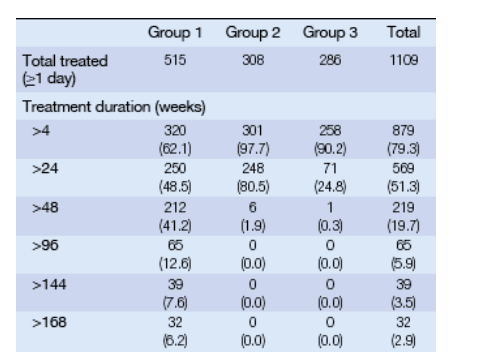
ABSTRACT
OBJECTIVES:
BI 1182.17 is a long-term, open-label trial examining the safety and tolerability of TPV/r (dosed 500 mg/200 mg twice daily). The study was primarily designed to allow patients who participated in phase 2 and 3 trials to continue to receive
TPV/r and to provide long-term safety follow-up.
METHODS:
HIV+ patients who had completed any previous TPV phase 2 or 3 trial, or who were virologic failures from the comparator arm of the phase 3 RESIST studies, were eligible for enrollment. Patients were assessed for laboratory tests on
days 1, 14, and 28, month 3, and standard tri-monthly visits thereafter.
RESULTS:
Safety results from 1109 patients were included and stratified by duration of exposure to TPV. Patients from the earliest trials had exposure to TPV beyond the >48-96 weeks timeframe, with 65 patients >96-144 weeks exposure, and 39 patients >144 weeks exposure.
Overall, the majority of adverse events were mild or moderate in intensity. Most AEs occurred in the first 24 weeks of therapy and their incidence decreased over
time. The most frequently reported AEs (since start of TPV) for all patients were diarrhea (34.5%), nausea (24.0%), fatigue (13.3%), and headache (12.3%). Overall, 8.9% of patients (n=99) and 4.4% patients (n=49) had grade 3 or 4 ALT and AST, respectively. Most increases occurred within the first 24 weeks and were grade 3. Only 7 patients had grade 3 or 4 total bilirubin. There were no new AEs with TPV/r after week 24 that had not been reported during the first 24 weeks. Thirty-two patients were followed for >168 weeks and 21 of them (65.6%) sustained a confirmed >1 log10 VL reduction. Severe adverse events were reported for 278/1109 (25%) patients.
CONCLUSION:
In this cohort of treatment-experienced patients who had received TPV/r for up to 4 years, AEs were generally mild or mild to moderate in intensity and were not associated with treatment discontinuation.
INCIDENCE OF SEVERE ADVERSE EVENTS
Table 3. Number (%) of Patients With Severe Adverse Events in >1% of
Patients Overall
Overall, the majority of adverse events were mild or moderate
in intensity
The overall frequency of mild, moderate, and severe events did not differ greatly between time intervals for each of the 3 groups. Severe adverse events were reported for 278/1109 (25.1%) patients
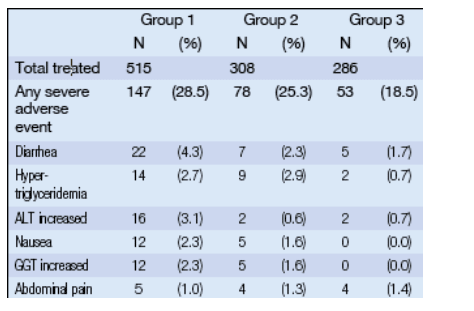
INCIDENCE OF GRADE 3 OR 4 LAB ABNORMALITIES
Table 4. Number (%) of patients with Grade 3 or 4 laboratory abnormalities >5%
* Increases in GGT are generally a result of Cytochrome P450 induction caused by TPV/r, and not a toxicity
GGT=Gamma-glutamyltransferase; ALT=Alanine aminotransferase; AST=Aspartate aminotransferase.
--In general, Grade 3 or 4 laboratory abnormalities occurred with greater frequency in Groups 1 (early studies) and 2 compared with Group 3 (RESIST)
--Overall, the most frequently reported Grade 3 or 4 laboratory abnormality was an increase in GGT (21.2%) followed by an increase in triglycerides (16.1%)
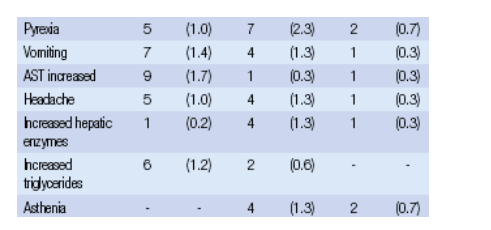
MOST FREQUENTLY REPORTED ADVERSE EVENTS BY
EXPOSURE TIME
Table 5. Most Commonly Reported Adverse Events by TPV/r Exposure Time*
--Only Group 1 patients had exposure to TPV/r in excess of 96 weeks
No new or unexpected adverse events were observed during and up to 4 years of follow-up:
- No events appeared later in the course of therapy (>24 weeks) that were not present earlier during therapy (<24 weeks)
- In general, the incidence of AEs-including GI AEs- decreased over time
Lower incidence of AEs-including diarrhea and nausea-in patients initiating marketed formulation and dose of TPV (Groups 2 and 3)
*For this analysis, an AE is reported to occur in the time interval in which it first appeared.
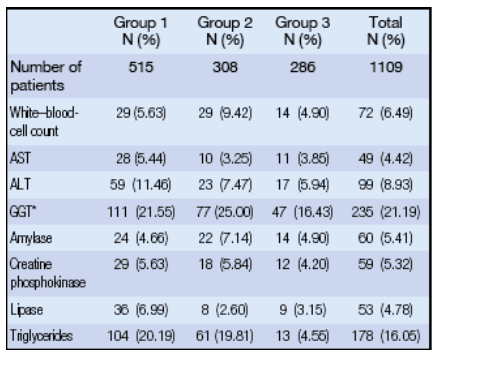
SUMMARY OF ADVERSE EVENTS LEADING TO DISCONTINUATION AND DEATH
Table 6. Summary of treatment-emergent adverse events leading to
discontinuation or death*
Overall, the most frequently reported adverse events leading to discontinuation were nausea (1.7%), diarrhea (1.2%), and increased ALT (1.0%)
Frequencies of patients discontinuing due to AEs were greater in Group 1 compared with Groups 2 and 3
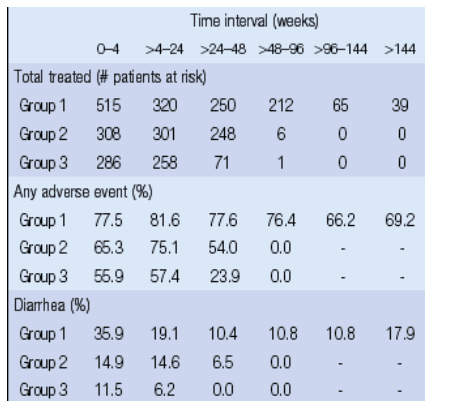
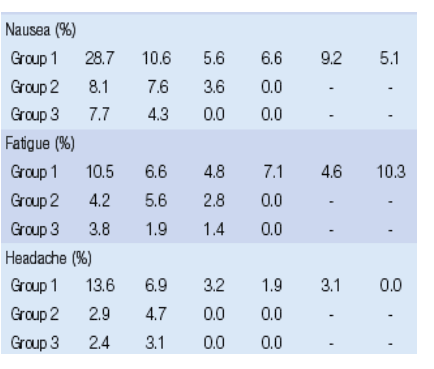
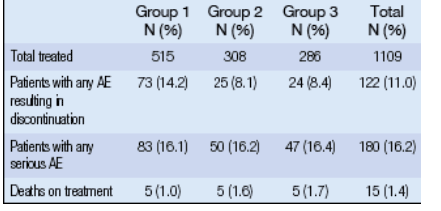
METHODS
To enroll in this study, patients must have been enrolled in 1 of 7 previous TPV/r trials: BI 1182.2, BI 1182.4, BI 1182.6, BI 1182.51, BI 1182.52, RESIST-1, or RESIST-2. Patient inclusion criteria included:
STUDY DESIGN
Patient Group 1 (earliest studies):
Trials 1182.2, 1182.4, and 1182.6 were early TPV trials with various dose regimens and formulations
- 1182.2: dual PI regimen-experienced, NNRTI-naïve patients (500 mg/100 mg or 1000 mg/100 mg TPV/r)
- 1182.4: single PI regimen-experienced patients (500 mg/100 mg or 1250 mg/100 mg TPV/r)
- 1182.6: NRTI- and NNRTI-experienced patients (1250 mg/100 mg, 750 mg/100 mg of 250 mg/200 mg TPV/r)
Trial 1182.52: triple ARV class, dual PI-experienced patients. This was a dose-ranging study in which 3 dose combinations of TPV/r were used (500 mg/100 mg, 500 mg/200 mg, and 750 mg/200 mg TPV/r)
Patient Group 2 (dual-boosted PI study):
_Patients from 1182.51 were triple ARV class-experienced, dual PI regimen-experienced and multi-PI-resistant patients, who may have received another PI
concurrently with TPV/r (TPV/r 500 mg/200 mg)
- BI 1182.51 is presented separately as the relative safety profile of a dual-boosted PI regimen, which may be different to other populations studied
Patient Group 3 (most recent studies)
_RESIST-1 and RESIST-2: triple ARV class-experienced and dual PI regimen-experienced patients who were virologic failures
- Data for CPI/r virologic failures from the phase 3 pivotal RESIST-1 and RESIST-2 trials are presented separately as this TPV/r-naive group is expected to have an acute (short-term) safety profile similar to other trials in which patients are treated for the first time with TPV/r and because few patients (n=71) will have reached >24 weeks
Note: Patients were followed from their first dose of TPV/r until their most recent visit in the 1182.17 rollover trial.
BASELINE DEMOGRAPHICS AND CHARACTERISTICS
Table 1. Demographic, Virology, and Immunology Characteristics
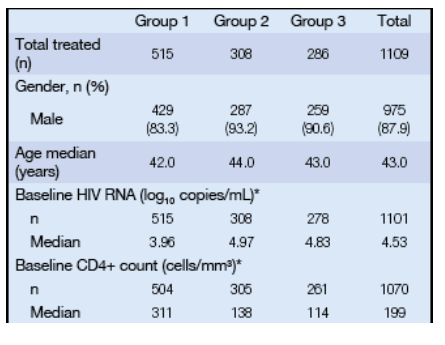
|
| |
|
 |
 |
|
|